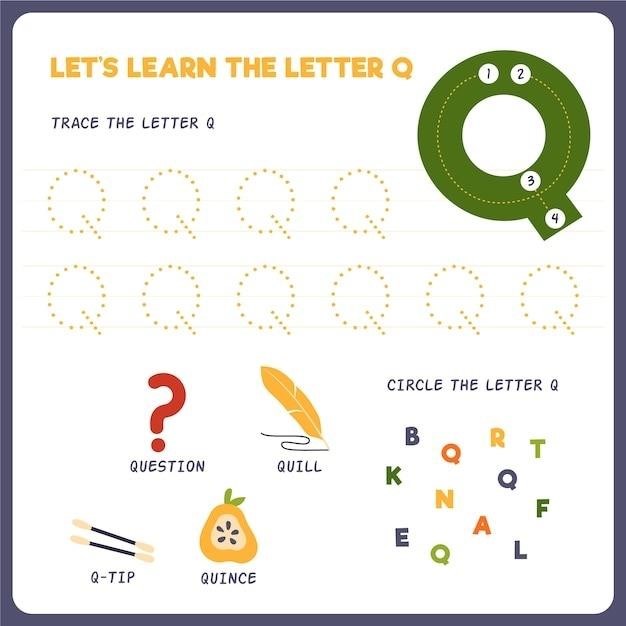
Unit Circle Worksheet with Answers PDF⁚ A Comprehensive Guide
This comprehensive guide will delve into the world of unit circle worksheets with answers, providing you with a deep understanding of this fundamental concept in trigonometry. The unit circle is a powerful tool for visualizing and understanding trigonometric functions, and worksheets offer a structured way to practice and solidify your knowledge. We’ll explore the key concepts, terminology, and applications of the unit circle, equipping you with the skills to confidently tackle any problem involving trigonometric values. Get ready to unlock the secrets of the unit circle with our step-by-step guide and practice problems.
Introduction
The unit circle, a fundamental concept in trigonometry, provides a visual representation of trigonometric functions and their relationships. It’s a powerful tool for understanding angles, radians, and the values of sine, cosine, and tangent. Unit circle worksheets with answers offer a structured way to practice and solidify your understanding of this essential concept. These worksheets typically include problems that involve finding trigonometric values for specific angles, converting between degrees and radians, and applying the unit circle to solve various trigonometric problems.
Whether you’re a student preparing for an exam, a teacher looking for supplementary resources, or simply someone interested in deepening your knowledge of trigonometry, unit circle worksheets with answers can be a valuable asset. They provide a clear and concise way to learn the principles of the unit circle, develop problem-solving skills, and enhance your overall understanding of trigonometric functions.
Understanding the Unit Circle
The unit circle is a circle with a radius of 1 centered at the origin of a coordinate plane. It’s a powerful tool in trigonometry because it visually represents the relationship between angles and trigonometric functions. Each point on the unit circle corresponds to an angle measured counterclockwise from the positive x-axis. The x-coordinate of this point represents the cosine of the angle, while the y-coordinate represents the sine of the angle.
The unit circle is divided into four quadrants, each with its own set of trigonometric values. For example, in the first quadrant, all trigonometric functions are positive. In the second quadrant, only sine is positive, while cosine and tangent are negative. Understanding these quadrantal relationships is crucial for accurately determining trigonometric values.
The unit circle also helps to visualize the periodicity of trigonometric functions. Since the circle has a circumference of 2π, the values of trigonometric functions repeat every 2π radians or 360 degrees. This understanding is essential for solving trigonometric equations and analyzing periodic phenomena.
Key Concepts and Terminology
To effectively utilize a unit circle worksheet, it’s essential to grasp key concepts and terminology. Here are some fundamental terms you’ll encounter⁚
- Angle Measure⁚ Angles on the unit circle are typically measured in radians, which are a ratio of the arc length to the radius. However, degrees are also used.
- Trigonometric Functions⁚ The six trigonometric functions – sine (sin), cosine (cos), tangent (tan), cosecant (csc), secant (sec), and cotangent (cot) – are defined based on the coordinates of a point on the unit circle.
- Quadrants⁚ The unit circle is divided into four quadrants, each with its own unique characteristics concerning the signs of trigonometric functions.
- Reference Angle⁚ The reference angle is the acute angle formed between the terminal side of an angle and the x-axis. It helps determine the trigonometric values of angles in different quadrants.
- Unit Circle Values⁚ The unit circle allows you to find the exact values of trigonometric functions for specific angles.
Understanding these concepts is crucial for solving problems involving trigonometric values and interpreting the results obtained from the unit circle worksheet.

Using the Unit Circle to Find Trigonometric Values
The unit circle is a powerful tool for determining the values of trigonometric functions for various angles. Here’s how it works⁚
- Locate the Angle⁚ Identify the angle on the unit circle, measured in radians or degrees.
- Coordinates⁚ The coordinates of the point where the angle intersects the unit circle represent (cos θ, sin θ), where θ is the angle.
- Trigonometric Values⁚ The x-coordinate of the point gives you the cosine value (cos θ), and the y-coordinate gives you the sine value (sin θ).
- Other Functions⁚ You can calculate the values of other trigonometric functions (tan θ, csc θ, sec θ, cot θ) using the relationships between sine, cosine, and tangent. For example, tan θ = sin θ / cos θ.
Unit circle worksheets often provide a blank unit circle for you to fill in with these values, helping you visualize and understand the relationship between angles and trigonometric functions.
Solving Problems Involving the Unit Circle
Unit circle worksheets often present various problems that test your understanding of the unit circle and its applications. These problems can range from simple exercises like finding the sine or cosine of a given angle to more complex scenarios involving trigonometric identities, equations, or even word problems. Here are some common types of problems you might encounter⁚
- Finding Trigonometric Values⁚ Determining the sine, cosine, tangent, and other trigonometric values for specific angles using the unit circle.
- Solving Trigonometric Equations⁚ Using the unit circle to find solutions to equations involving trigonometric functions.
- Simplifying Expressions⁚ Applying trigonometric identities and unit circle values to simplify complex trigonometric expressions.
- Word Problems⁚ Applying trigonometric concepts and the unit circle to solve real-world problems involving angles, distances, or other related quantities.
By working through these types of problems, you’ll develop a strong understanding of the unit circle and its role in solving various trigonometric applications.
Practice Problems and Solutions
Practice problems are the backbone of mastering the unit circle. Unit circle worksheets with answers are invaluable resources for this purpose. They provide a structured way to test your understanding and identify any areas where you need more practice. The problems are carefully designed to cover various aspects of the unit circle, from basic trigonometric values to more complex applications. Each problem is accompanied by a detailed solution, allowing you to check your work and understand the reasoning behind each step.
These worksheets offer a variety of problem types, such as finding the sine, cosine, and tangent of specific angles, solving trigonometric equations, simplifying expressions, and applying the unit circle to real-world scenarios. By working through these problems, you’ll gain confidence in your understanding of the unit circle and develop the skills needed to tackle more complex trigonometric tasks.
Worksheet Examples and Solutions
Let’s dive into some concrete examples of unit circle worksheets with answers. These worksheets typically present a series of problems, ranging from basic to more challenging, that require you to apply your knowledge of the unit circle. Here’s a glimpse of what you might encounter⁚
Example 1⁚ Find the sine, cosine, and tangent of 30 degrees. You’d use the unit circle to locate the point corresponding to 30 degrees and then use the coordinates of that point to determine the trigonometric values. The solution would provide the correct answers along with an explanation of how they were derived.
Example 2⁚ Find the angle (in radians) that corresponds to the point (-1/2, √3/2) on the unit circle. You’d use the unit circle to identify the angle that aligns with those coordinates, and the solution would guide you through the process.
These examples demonstrate how unit circle worksheets with answers provide a comprehensive learning experience, enabling you to practice your skills and gain deeper understanding through the step-by-step solutions.
Applications of the Unit Circle
The unit circle isn’t just a theoretical concept; it has practical applications in various fields. Here are some key areas where understanding the unit circle proves invaluable⁚
Trigonometry and Calculus⁚ The unit circle forms the foundation for understanding trigonometric functions and their derivatives, which are crucial in calculus. It helps visualize relationships between angles, radians, and trigonometric values, simplifying complex calculations.
Physics and Engineering⁚ The unit circle is used to analyze periodic phenomena like waves and oscillations in physics and engineering. It helps in representing and understanding the behavior of these phenomena, leading to more accurate models and predictions.
Navigation and Mapping⁚ The unit circle is applied in navigation systems and mapping applications. It helps determine positions, distances, and directions based on angles and coordinates, making it essential for accurate location tracking.
Computer Graphics and Animation⁚ In computer graphics and animation, the unit circle is used for creating realistic movements and transformations. It helps define rotations, translations, and scaling of objects, leading to visually appealing and accurate animations.
Benefits of Using a Unit Circle Worksheet
Unit circle worksheets offer a multitude of benefits for students looking to master this fundamental concept in trigonometry. Here are some key advantages of using these worksheets⁚
Visual Reinforcement⁚ Worksheets provide a visual representation of the unit circle, allowing students to connect angles, radians, and trigonometric values in a tangible way. This visual reinforcement enhances understanding and retention.
Structured Practice⁚ The worksheets offer a structured approach to practicing unit circle concepts. They provide a range of problems, from basic to advanced, ensuring students develop a comprehensive understanding.
Immediate Feedback⁚ With answers provided, students can assess their understanding immediately, identifying areas where they need further clarification. This immediate feedback is crucial for effective learning.
Self-Paced Learning⁚ Worksheets allow students to learn at their own pace, focusing on areas where they need additional practice. This personalized approach enhances their confidence and understanding.
Preparation for Exams⁚ Unit circle worksheets are an excellent way to prepare for exams and assessments. They help students solidify their understanding of key concepts and develop the skills needed to solve trigonometric problems confidently.
Tips for Mastering the Unit Circle
Mastering the unit circle is a key step in your trigonometry journey. Here are some effective tips to help you navigate the unit circle with ease⁚
Memorize Key Angles⁚ Begin by memorizing the angles and their corresponding trigonometric values for the special right triangles (30-60-90 and 45-45-90). This forms the foundation for understanding the unit circle.
Visualize the Quadrant⁚ Understand the quadrants of the unit circle and the signs of trigonometric functions in each quadrant. This helps you quickly determine the sign of the trigonometric value for any given angle.
Utilize Reference Angles⁚ Every angle on the unit circle can be related to a reference angle in the first quadrant. Learning how to find these reference angles simplifies the process of finding trigonometric values.
Practice, Practice, Practice⁚ Regularly working through unit circle worksheets and problems is crucial for solidifying your understanding. This practice builds muscle memory and helps you recall trigonometric values quickly.
Use Flashcards⁚ Create flashcards with angles and their corresponding trigonometric values. Regularly reviewing these flashcards reinforces your memory and helps you learn the unit circle effectively.
The unit circle is a powerful tool in trigonometry, providing a visual representation of trigonometric functions and their relationships. Unit circle worksheets with answers are invaluable resources for mastering this concept. Through regular practice, you can develop a deep understanding of the unit circle, enabling you to solve a wide range of trigonometric problems with confidence. Remember, practice makes perfect, and consistent effort will lead you to a strong grasp of this fundamental concept. With dedication and the right resources, you can unlock the secrets of the unit circle and excel in your trigonometric studies.
So, grab your unit circle worksheet with answers, dive into the practice problems, and unlock the world of trigonometry. As you navigate the unit circle, you’ll discover a fascinating connection between angles, trigonometric values, and the beauty of mathematical relationships. Keep practicing, and you’ll soon find that the unit circle becomes an intuitive and indispensable tool in your mathematical journey.


